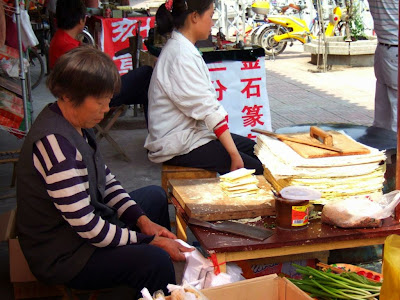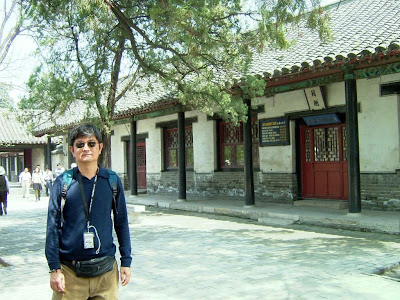
Qifu (曲阜), a city in south west of Shandong, was the capital of Lu State during Spring and Autumn period (770-476BC) and the home town of China greatest educational scholar Confucius (551-479BC). Qifu covering a total land area of 16,000 sq.meter with 460 rooms, is the second largest historical building complex in China after the Forbidden City of Beijing. The three most cultural sites in Qifu are known as San Kong (三孔) which includes Temple, cemetery and living mansion of Confucius. Confucius had been honored as The Sage since Tang Dynasty and his generations were highly respected by all emperors. They were given 100,000 over acres of land and were only binding by their own family law. Since year 1994, the place has been listed into Unesco world Heritage sites.


Education and study tide was very strong during Confucius era. Ancient Chinese classified writing paper, brushes, ink and rubbing slab as 4 treasured room stationery. Many stalls inside Confucius mansion are promoting such items and literary articles, perhaps as souvenir or collection for the tourists only, as young generations born in this IT world, do not find the stationery necessary any more.



We love Shandong fried pastry (煎 饼) that were sold in many shops or stalls along the road by the local women. This very common yet quite popular kind of tit'bit food for locals are hand-made, crispy, simple taste and cheap.


The shops and stalls in front of Confucius Temple.



The drum tower at south gate.



The wall at south gate.


Confucius Temple at his birth land, Qifu of Shandong Province was built during Tang Dynasty (618-917) and had been 21 times renovated during 276 yrs reign of Ming dynasty in 14-15th century. It is the biggest temple in the whole China nation.



Within the huge area of buildings, praising phrases or complimentary wordings for this great teacher were at every corners. The yellow wordings stated therein means Confucius was a star from heaven.


In 195 B.C. Confucius's generation was raised to duke nobility by Liu Pang of Han Dynasty. Emperor Liu Pang was the first emperor who came to the temple and made worship to Confucius, setting an example for other emperors in the subsequent dynasties to follow. There was a walkway constructed exclusively for Emperors to walk when making sacrifices offering to The Sage.



The main part of the complex consists of nine courtyards arranged on a central axis. The first three have small gates and are planted with tall pine trees.



Most of the structures have yellow roof tiles, red painted walls and surrounded by dark green pine trees, forming a complimentary contrast of colors.



The broken trunk of this ash tree (kui) was said to be personally planted by Confucius. It was as thriving as his teaching, still giving out sign of life after 2500 years.



Confucius complex suffered extensive damages during China's cultural revolution in mid 20th and 6000 pieces of artifacts were destroyed.



The main structures inside the Confucius Complex include its Stele Pavilion that was built within 1115 to 1368 during Jin and Yuan Dynasty, Kuiwen Hall that was first built in 1018 and restored in 1504 & 1985, Xing Tan Pavilion, Demu-Tiandi Arch, Hall of Confucius female family and Dacheng Palace that was built in Qing Dynasty.


The animals decorative roofs are impressive.



The ancient style of roofing structure looks nice and also strong. Chinese proverb (钩心斗角) read as gou xin dou jiao, hooking and fighting with each others heart and horn meaning internal or civil strife for own benefits among fellows of same society. The construction of these two ancient buildings vitalized the meaning of proverb where roof edges closely linked to each other to compete the beauty of own characteristic; corners and edges stood out together to outstanding its distinguishes. It would be very unfortunate and tiring in reality if one has to work under environment of such situation where every body is selfishly fighting hard for own good.




The building named Apricot Altar (Xintan Pavilion) was the place where Confucius had his school. Today it was still a symbol of study as children at Qifu would come and pray for good result at first year of study.



There are 13 pavilions of stone plague at Confucius Temples, with inscription in ancient calligraphy which are now the most precious artifacts of China.




Dacheng Palace (大成殿) supported by 28 richly decorated pillars is the architectural center of the present complex. It measures 54x34 meters with height of about 32 meters. The 6 meter high stone pillars were carved in one piece out of local rock with 0.8 meter in diameter.


The Sage, Confucius had been worshiped like an emperor. The stone columns at his palace temple are decorated with vitalized coiled dragon carvings, which were exclusively for emperors only in ancient China. They were made in year 1500 and were the best through out the whole nation.



Confucius (551-479 BC) and his generation for the past 2500 yrs never failed or ceased to receive great honor and respect in regardless of changes in dynasties and emperors. Images of Confucius and 4 of his students were at this main shrine Da Cheng Dian (大成殿) for generations to show respect. Dacheng Dian serves as the principal venue for offering sacrifices to the memory of Confucius. Since Han Dynasty the worship ceremony became officially nationwide.


The former house of Confucius in Qifu was consecrated as a temple by the Prince of Lu State two years after his death.


The original painting wall in one of the buildings and the old punishment board for those who made mistake to kneel on it for hours or overnight.



This was the old house where Confucius lived and the living shelters for his female family members was at the inner area of the mansion. It was very conservative during warring period in Lu state, females stood no position in the society and were strictly not allowed to show or expose in the public or in front of unknown males.


Confucius was the only family in China or perhaps in the whole world, who kept their family register (108 rolls) clearly recorded, extended for 2488 years. Each year on 28th September, Qifu and other Confucius temples around the world have great ceremony to commemorate Confucius birthday.


The two deities representing civil and military at the Confucius tomb. The block of tree trunk left at the garden was the tree planted by Confucius's student named Zhi Gong, who was away when the teacher passed away. He built a hut near the tomb and stayed there for three years to mourn his great master.




The red pavilion was the stable for horses built nearby Confucius tomb.


The cemetery garden of Confucius and his generations covered an area of 100 over acres. More than 100,000 of Confucius' descendants were buried here over a period of 2000 years and nearly 3000 tombstones dating from Song, Yuan, Ming and Qing Dynasty are still standing in the cemetery.


No comments:
Post a Comment